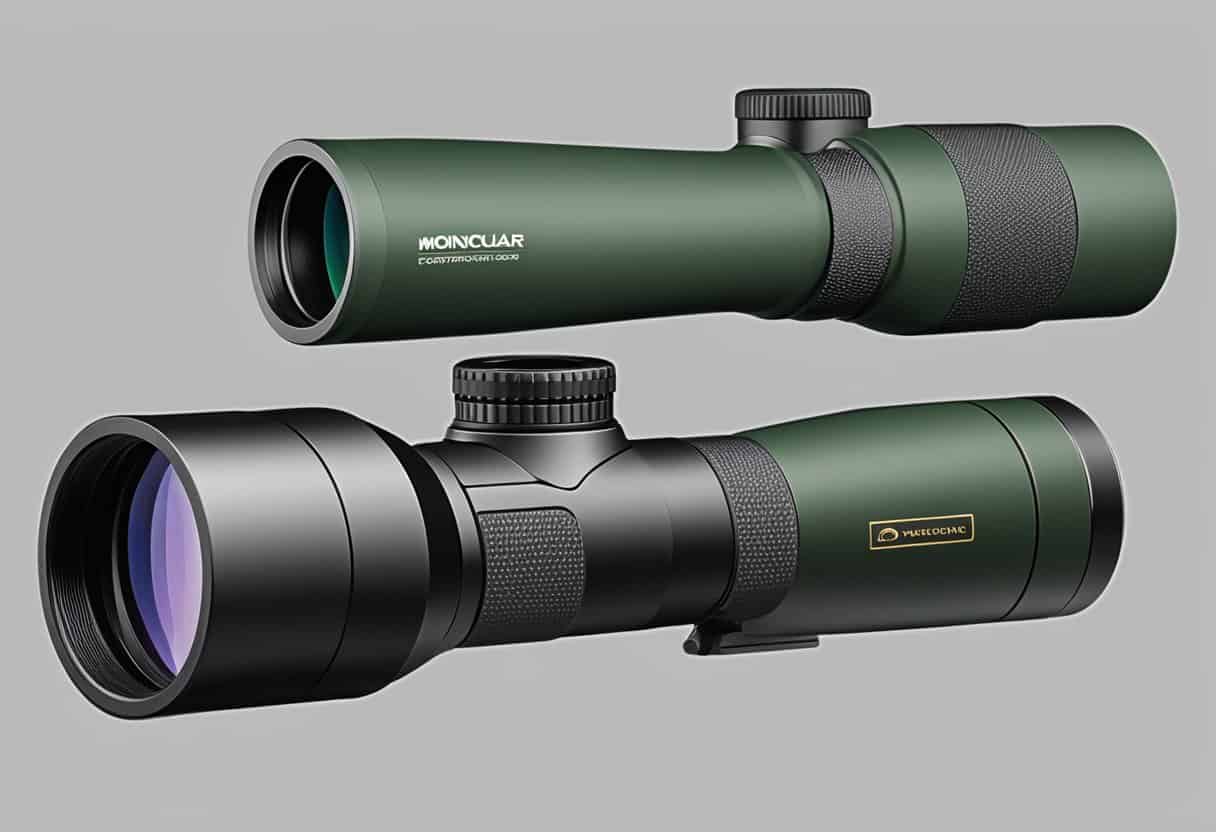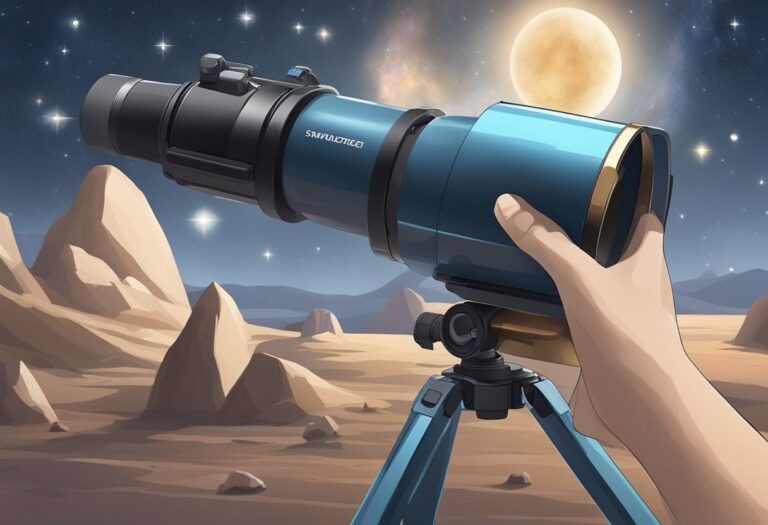When exploring the outdoors or engaging in activities like birdwatching and stargazing, having the right optical equipment can greatly enhance your experience.
Monoculars and spotting scopes are two popular options that provide magnified views of distant objects. While they might seem similar at first glance, each has distinct features that cater to different needs and preferences. Understanding how a monocular compares to a spotting scope involves looking at their optical performance, design, and specific use cases.
Monoculars are compact, lightweight devices that are easy to carry, making them ideal for those who need to minimize their gear weight. They can be swiftly pulled out of a pocket for quick viewing, affording convenience for casual observers and hikers. On the other hand, spotting scopes offer higher magnification power and superior image quality but are larger and often require a tripod for stability.
They are particularly favored by wildlife enthusiasts and amateur astronomers who require detailed, stable views over longer periods of observation.
Monoculars are compact and convenient for quick, casual viewing, while spotting scopes offer higher magnification and superior image quality, ideal for detailed, stationary observation. The choice depends on your specific viewing needs and activity requirements.
Basics of Monoculars and Spotting Scopes
In this section, you will learn the fundamental aspects of monoculars and spotting scopes, enabling you to understand their design, uses, and primary differences.
Overview of Monoculars
A monocular is a compact, portable optical device that you can hold in one hand. It’s essentially half of a pair of binoculars, designed for use with one eye. Monoculars come in various sizes and magnifications, typically ranging from 6x to 10x, meaning they can make an object appear six to ten times closer than it is to your naked eye. They’re ideal for quick, on-the-go viewing and can be easily slipped into a pocket or a backpack.
Overview of Spotting Scopes
On the other hand, a spotting scope is a small, portable telescope optimized for the observation of terrestrial objects. Larger and more powerful than monoculars, they often have magnifications from 15x to 60x. Spotting scopes usually require a tripod for stability given their high magnification and are favored for activities such as birdwatching, hunting, and target shooting where detailed, close-up views are essential.
Core Differences
When comparing monoculars and spotting scopes, consider the following key points:
- Portability: Monoculars are lighter and more compact.
- Magnification: Spotting scopes offer higher magnification levels.
- Stability: Spotting scopes typically need a tripod.
- Usage: Monoculars are suited for quick, casual viewing, while spotting scopes are better for prolonged, detailed observation.
Your choice between a monocular and a spotting scope will depend on your specific needs, whether it’s the convenience of a monocular or the detailed imagery from a spotting scope.
Optical Performance
In evaluating optical devices, you’ll notice that factors such as magnification, lens size, image quality, and ease of focus significantly impact their effectiveness.
Magnification and Objective Lens
The magnification of a monocular is typically in the range of 5x to 36x, providing a good balance between zoom and portability. Spotting scopes often boast higher magnification levels, typically starting at 15x and can go up to 75x or more, suitable for distant subjects. The size of the objective lens in both devices is crucial; larger lenses, measured in millimeters, gather more light, enhancing image brightness and clarity.
Image Quality and Field of View
Your experience with image quality depends greatly on the optic’s technology. High-end monoculars and spotting scopes use advanced coatings and glass to deliver crisp, high-contrast images. The field of view, measured in feet at 1,000 yards, often shrinks as magnification increases. A reduced field of view can make locating and tracking subjects more challenging, particularly at high zoom levels.
Ease of Focus
Focusing mechanisms vary between monoculars and spotting scopes, each offering different levels of precision and speed. Monoculars often feature a simple twist-up eyecup and a focusing ring for quick adjustments. Conversely, spotting scopes may offer dual-speed focusers that allow for both rapid and fine-tuned image adjustments, giving you more control for detailed observation.
Portability and Design

When choosing between a monocular and a spotting scope, your decision often hinges on how you prioritize portability and the robustness of design.
Size and Weight
Monoculars are essentially half a binocular, making them particularly lightweight and compact. Their design allows you to carry them in a pocket or a small pouch—ideal for when you need to minimize your gear. For instance, a next-generation long-range thermal monocular can combine small size with powerful magnification.
Spotting scopes, however, tend to be larger and heavier by design due to their more powerful optics and features tailored for stationary observation. Their weight adds stability, an essential factor when you’re after high magnification levels to study distant objects or landscapes.
Durability and Build Quality
The build quality of monoculars often reflects their purpose as a portable and accessible option for quick viewing. Many models are encased in a rugged, rubberized coating providing a degree of shock resistance and grip. The durability criteria become important if you’re integrating them with other equipment, such as attaching a thermal monocular in front of a rifle scope.
In the case of spotting scopes, durability is geared towards longevity and endurance in a fixed position outdoors. They frequently feature reinforced bodies, waterproof and fog-proof capabilities, and often require a tripod for stability. A spotting scope’s construction is tailored to endure long hours of observation in a variety of environmental conditions.
Use Cases
Monoculars and spotting scopes offer varying functionalities suitable for particular use cases. Your choice between the two depends on specific activities and requirements.
Wildlife Observation
When observing wildlife, monoculars are typically lightweight and portable, making them convenient for quick viewing. They are easy to carry, allowing you to swiftly catch sight of animals in their natural habitat. On the other hand, spotting scopes provide more powerful magnification and better image stability, ideal for detailed observations over long distances.
Astronomy
For amateur stargazing, monoculars are a compact option, though they may offer limited celestial views due to less powerful magnification. Spotting scopes, however, often boast greater magnification capabilities, and when mounted on a tripod, they offer stable and clear views of the moon and planets.
Hunting and Shooting
If you’re a hunter or involved in shooting sports, a monocular can provide a quick way to scout terrain or follow prey due to its one-handed operation. Spotting scopes are instrumental for shooters who need to make precise shots over longer distances or want to confirm shot placement due to their enhanced magnification and steadiness.
Travel and Hiking
Travelers and hikers benefit from monoculars as they are easy to pack and don’t add much weight to your gear. However, if your travels include bird watching or viewing landscapes from a stationary position, then a tripod-mounted spotting scope can enrich your experience with more detailed visuals.
Price and Accessibility
When considering monoculars and spotting scopes, your budget and where you can purchase these items are key factors.
Cost Comparison
Monoculars often provide a cost-effective option for on-the-go observation, with prices substantially lower than spotting scopes. You’ll find basic monoculars starting from as low as $20, catering to casual users who require a lightweight, portable device. On the other hand, spotting scopes, designed for more serious observers and hobbyists, come with a higher starting price around $100, reflecting their advanced optics and durability.
Availability and Variety
You have widespread access to monoculars through a variety of retailers, from outdoor stores to online platforms. Their variety ranges from simple models suited for quick viewing to high-end versions with enhanced features like night vision. Spotting scopes, while less readily available than monoculars, can be found at specialty stores focusing on optics or hunting equipment. Here, the selection varies from entry-level scopes suitable for backyard birdwatching to professional-grade gear with premium prices, indicating a more targeted market.
Frequently Asked Questions
In this section, you’ll find targeted answers to common queries about the usage and characteristics of monoculars and spotting scopes, giving you clarity to choose the right optic tool for your adventures.
What are the advantages of a compact spotting scope over larger models?
Compact spotting scopes offer easier portability and are generally less cumbersome than their larger counterparts. This makes them ideal for travelers or hikers who prioritize lightweight gear without sacrificing quality observation capabilities.
How can one decide between a spotting scope and binoculars for bird watching?
When deciding between a spotting scope and binoculars for bird watching, consider magnification and stability. Spotting scopes provide higher magnification and are typically mounted on tripods, offering a stable and close-up view essential for detailed observation of birds, especially at long distances.
In terms of power and portability, how does a monocular compare with a spotting scope for hunting?
A monocular is often more portable than a spotting scope due to its lighter weight and single-lens construction. While spotting scopes generally offer higher magnification and better optics, a monocular can be a powerful tool for hunters needing a quick and easy way to scout terrain or track game.
Why might someone choose a spotting scope for observing wildlife over a monocular?
Spotting scopes are chosen for observing wildlife when high magnification and image stability are paramount. They are particularly useful for viewing at great distances or in detail, as they can be mounted on tripods to eliminate hand shake and are often equipped with superior optics for clearer images.
When comparing the magnifications of 12×50 and 40×60, which is better for a monocular?
The magnification and lens diameter of a monocular are crucial for image clarity and light gathering. A 12×50 monocular offers a balance of magnification and a wide lens for good light, suitable for diverse settings. A 40×60 provides high magnification and a large lens, which is ideal for stationary, long-range observation in bright conditions.
Is it feasible to utilize a monocular in place of a traditional rifle scope?
Utilizing a monocular in place of a traditional rifle scope is not recommended due to the differences in design and purpose. Rifle scopes are specifically engineered for alignment with the firearm’s barrel, and provide reticles for aiming, which monoculars do not. A monocular is intended for spotting or observing at a distance rather than precision aiming.







